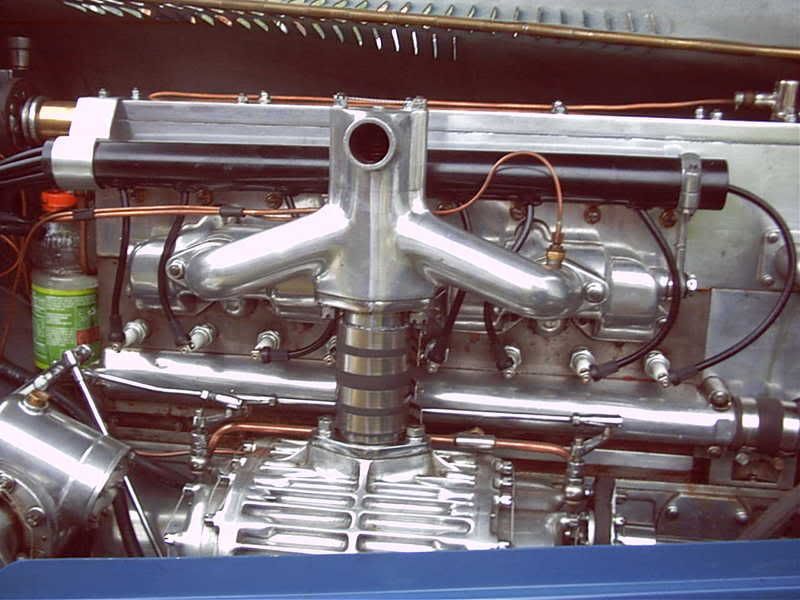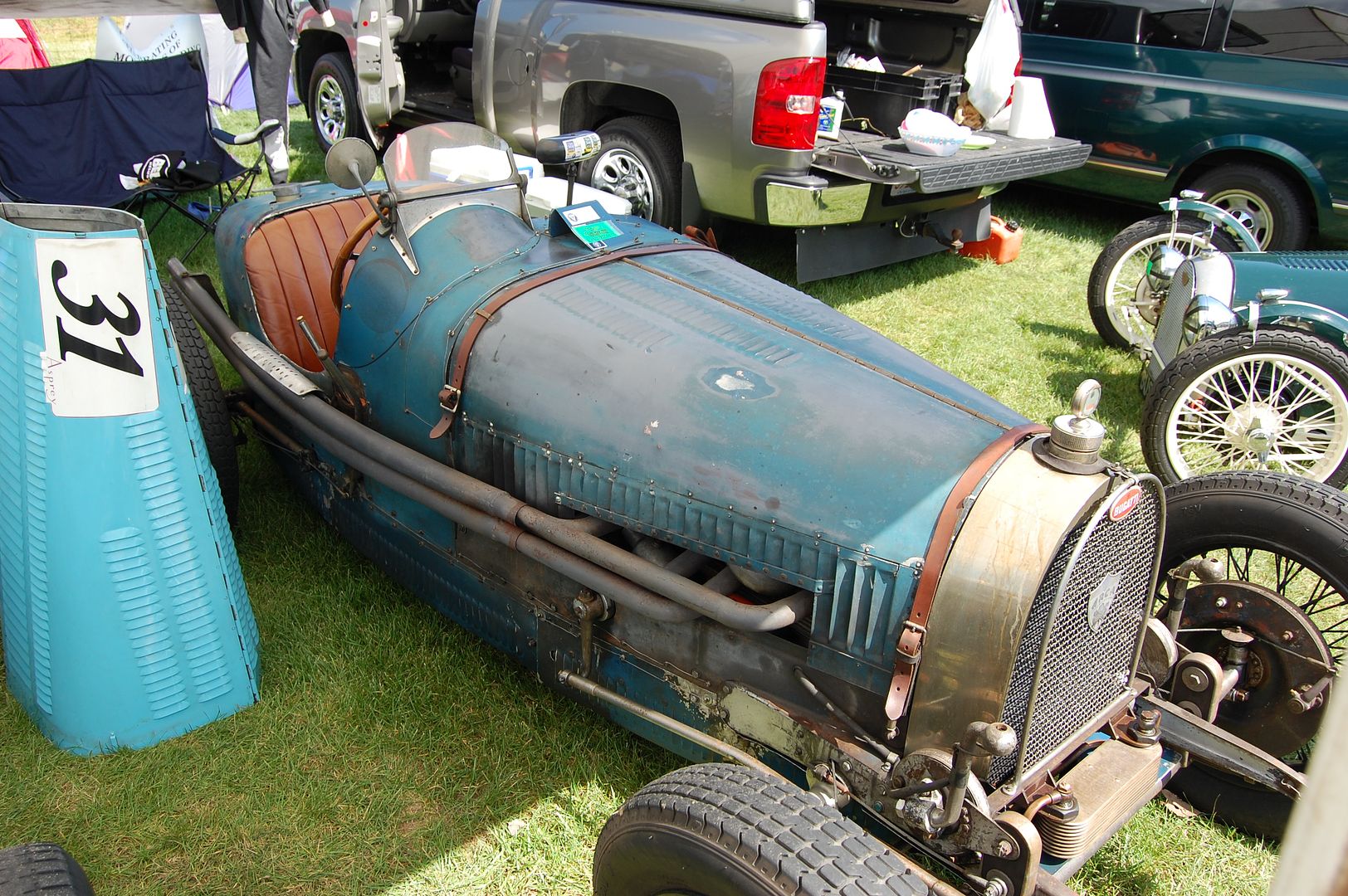Bugatti bought by canny car fan for £60 in 1950 sells for £430,000
then

now
 http://www.dailymail.co.uk/news/article-2011123/1925-Bugatti-bought-1950-60-sells-430-000.html
http://www.dailymail.co.uk/news/article-2011123/1925-Bugatti-bought-1950-60-sells-430-000.html
Bugatti bought by canny car fan for £60 in 1950 sells for £430,000
then

now
 http://www.dailymail.co.uk/news/article-2011123/1925-Bugatti-bought-1950-60-sells-430-000.html
http://www.dailymail.co.uk/news/article-2011123/1925-Bugatti-bought-1950-60-sells-430-000.html
are those tubes.. or a sumpguard.
as for tubes through an oilpan for cooling.. I had always wondered if that would work
That's a pretty nice return on his investment, even though 60 pounds in 1950 was approx 1/6 of the average yearly wages according to the Internet (just to put the roughly $240 he paid at the then-current exchange rate for the car in perspective). Mind you, it's worth a little more than 1/6th of the average yearly salary now.
That said, I'm surprised he managed to pick it up that cheaply as a most of the cars built in the UK at that time were destined for export to pay for the war and the debts thus incurred. As a result, used cars were in huge demand back then.
In reply to mad_machine:
If you look at the bottom of the pan there, you can see fins, like on todays aluminium pans. Trying to think of how you would install the pickup in there.
mad_machine wrote: are those tubes.. or a sumpguard. as for tubes through an oilpan for cooling.. I had always wondered if that would work
I have seen tubes through the oil pan for shifter linkage...that was certainly interesting.
BoxheadTim wrote: That's a pretty nice return on his investment, even though 60 pounds in 1950 was approx 1/6 of the average yearly wages according to the Internet (just to put the roughly $240 he paid at the then-current exchange rate for the car in perspective). Mind you, it's worth a little more than 1/6th of the average yearly salary now. That said, I'm surprised he managed to pick it up that cheaply as a most of the cars built in the UK at that time were destined for export to pay for the war and the debts thus incurred. As a result, used cars were in huge demand back then.
People only made 360 pounds a year in 1950? The value of a pound has dropped that much?
Joey
fasted58 wrote: ^ this guy been racin' a 1926 Type 35B at the Pittsburgh Vintage Grand Prix for years
Yep, I've seen that car. (The Porsche too).
I'm running the PVGP this year (in a Sprite).
A few years ago, there was like 8 of those things at the Lime Rock Vintage. One guy flew an unrestored barnfind T35b in from Australia just for the event. It was all shabby and crusty but went like he11 and sounded wonderful
Bugs at Lime Rock

Most of these cars have a "back-fire hole" in the bonnet. And a special one-way valve that allows the engine to backfire if the superchager is overdoing things. Cool!

One cool old Bugatti is this one (below....and often seen at the LR Vintage). During the 40s, someone took out the proper straight eight engine and used it in a speedboat! The engineless car languished for years, until it was bought for a song and the new owner put a Model A Ford engine in it! It's been racing for over 30 years like this......a complete rat, but great fun to watch.

joey48442 wrote: People only made 360 pounds a year in 1950? The value of a pound has dropped that much? Joey
Just for a reference point, my father was a foreman in a munitions plant in 1950. He earned $100/month (CDN) at the time. The 1949 Austin A40 he bought that year cost $1440 used !
aeronca65t wrote: A few years ago, there was like 8 of those things at the Lime Rock Vintage. One guy flew an unrestored barnfind T35b in from Australia just for the event. It was all shabby and crusty but went like he11 and sounded wonderful
I think I know that car. I have photos of it from the Phillip Island Historic a few years ago, in the same unrestored state.
DILYSI Dave wrote: When on the automotive development timeline did we realize that positive camber was a bad thing?
Since developing an interest in cycle karts that question has been on my mind too. Other questions are:
-Why did they use pc in the first place?
-What is the advantage of using it? (probably the same?)
I really don't know the answers and even googled them. I suspect it had to do with the evolution of wider and new construction for racing tires as well as independent suspension designs. I'll bet that someone from the forum will have the answers though.
fasted58 wrote:
That's my ideal car.....it is just pure awesomeness.
There's' a picture of a Type 35 on the wall in my garage. If I had known about these cars back in 2008, I would have started a replica of one of them instead of the datsun.
aeronca65t wrote:fasted58 wrote:
I love the period-accurate gatorade bottle attached to the front of that engine. It really ties the restoration together.
DILYSI Dave wrote: When on the automotive development timeline did we realize that positive camber was a bad thing?
When they redesigned the tires that were going on them. I think it all had to do with the tire construction. I think they also increased stability.
not sure what the value of the pound was then.. but I remember my grandmother (a war bride from London) once mentioning an 18 to 1 ratio.. (18 USD to 1 pound)
Graefin10 wrote:DILYSI Dave wrote: When on the automotive development timeline did we realize that positive camber was a bad thing?Since developing an interest in cycle karts that question has been on my mind too. Other questions are: -Why did they use pc in the first place? -What is the advantage of using it? (probably the same?) I really don't know the answers and even googled them. I suspect it had to do with the evolution of wider and new construction for racing tires as well as independent suspension designs. I'll bet that someone from the forum will have the answers though.
It helped a good bit with the steering effort; if you draw a line throught the kingpin to the ground it passes very close to the center of the tire tread. That makes for a minimal scrub radius, making the car much easier to steer. Also as I understand it, positive camber was used to take some of the load off of the kingpins in the front suspension. Metallurgy wasn't like it is now. ![]()
The T35b is probably my favorite prewar race car. Something about them is just proportioned so right...
Curmudgeon wrote:Graefin10 wrote: I'll bet that someone from the forum will have the answers though.It helped a good bit with the steering effort; if you draw a line throught the kingpin to the ground it passes very close to the center of the tire tread. That makes for a minimal scrub radius, making the car much easier to steer. Also as I understand it, positive camber was used to take some of the load off of the kingpins in the front suspension. Metallurgy wasn't like it is now.
As always, you guys are a wealth of knowledge.
I'm sure you guys did the same thing I did, which is try to understand how the suspension works as well as steering. One thing I noticed is that the kingpins are very short so I can see that the stresses on them would be much greater than longer ones.
It's not obvious to me how the front suspension works. Where are the springs? Where and how does it mount? I see that it has adjustable friction shocks, which from what I've read actually worked pretty good . . . for a while anyway. I get a feeling that Ettore was of the same mindset as Colin Chapman. I THINK it must use quarter elliptical front springs that are contained inside sheet metal to contain grease and keep out water and dirt. I car sort of see that in the pics. One of the bugatti racing pictures is now my desktop wallpaper replacing a bare wooden frame of a boat I hope to build someday.
I saw a VW powered Bugatti replica kit car a few years ago that was well done and really did capture the essence of the originals. Wouldn't want one myself though.
You'll need to log in to post.